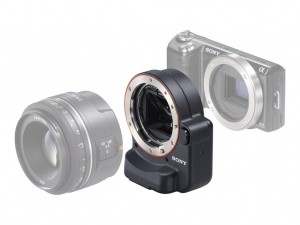Sony Steps up its Game with its Latest Alpha Series Cameras
 Digital cameras have always been popular gift items, and digital SLRs are bound to be a popular seller this holiday season. While you might be tempted to go with the tried and true performance of a Canon or Nikon, you may want to look into what Sony has cooked up with its latest Alpha Series.
Digital cameras have always been popular gift items, and digital SLRs are bound to be a popular seller this holiday season. While you might be tempted to go with the tried and true performance of a Canon or Nikon, you may want to look into what Sony has cooked up with its latest Alpha Series.
The α77 and α65
The big selling point of the α77 and α65 is Sony’s brand new Translucent Mirror Technology. Traditionally, SLR cameras (the film kind) used a mirror placed in front of the shutter to allow you to see through the lens when looking through the viewfinder. It let the autofocus circuitry peek through the lens as well. The problem is that when you take a photo, the mirror flips up out of the way of the shutter. This wasn’t much of an issue with film, but digital cameras can take photos much faster, and can even shoot video.
While companies like Canon and Nikon have simply taken the familiar route they’ve used for ages in their film cameras and applied it to their digital cameras, Sony has introduced a revolutionary new idea, a mirror that simultaneously lets light pass through it to the shutter while also reflecting light to the autofocus sensors. This allows for true continuous autofocus, regardless of frames per second. Canon and Nikon use a predictive autofocus method that, put simply, doesn’t even compare, especially in high speed shots.
 As would be expected with any high-end SLR, these two cameras set the bar in cutting edge features and performance. One notable feature is the Tru-Finder, essentially a digital viewfinder with an OLED display inside. It allows you to see information on top of the image, just as you would on the LCD display. It also works great in low light situations, an area where traditional viewfinders struggle. In all, both the α77 and α65 compare very well to Canon and Nikon’s competing models (the 60D, 7D, D5100, and D7000), even outclassing them in some key points, like image sensor size, light sensitivity, and focus points.
As would be expected with any high-end SLR, these two cameras set the bar in cutting edge features and performance. One notable feature is the Tru-Finder, essentially a digital viewfinder with an OLED display inside. It allows you to see information on top of the image, just as you would on the LCD display. It also works great in low light situations, an area where traditional viewfinders struggle. In all, both the α77 and α65 compare very well to Canon and Nikon’s competing models (the 60D, 7D, D5100, and D7000), even outclassing them in some key points, like image sensor size, light sensitivity, and focus points.
The NEX series is another product of Sony’s innovative nature. Traditional SLR designs were built around the limitations that came with film cameras. The NEX series does away with the SLR bulk but keeps almost all of the SLR internal components, like interchangeable lenses, manual controls, and large image sensors. In fact, the NEX-7 actually has the same 24MP image sensor found in the α77.
 Compared to the NEX-7, the NEX-5n does dial things back a bit, featuring only a 16MP image sensor (though it’s still full-sized) and lacking a viewfinder and hot shoe. The NEX-5n’s only true competitor is Nikon’s brand new J1. The J1 does offer a few more gimmicky features, but sacrifices a lot in image quality. Even our current leader, the Rebel T3i, is bested in many cases by the NEX-5n.
Compared to the NEX-7, the NEX-5n does dial things back a bit, featuring only a 16MP image sensor (though it’s still full-sized) and lacking a viewfinder and hot shoe. The NEX-5n’s only true competitor is Nikon’s brand new J1. The J1 does offer a few more gimmicky features, but sacrifices a lot in image quality. Even our current leader, the Rebel T3i, is bested in many cases by the NEX-5n.
 The biggest limitation of the NEX line is the fact that they all use the E-mount lens, of which, there are only a handful to choose from; however, this all changes when you throw in the Alpha mount adapter. The LA-EA2 adapter even includes the translucent mirror technology, allowing for continuous autofocus. That adapter would effectively turn the NEX-7 into an α77 (minus a bit of image stabilization and a few frames per second in burst mode) at a quarter of the size and half the weight.
The biggest limitation of the NEX line is the fact that they all use the E-mount lens, of which, there are only a handful to choose from; however, this all changes when you throw in the Alpha mount adapter. The LA-EA2 adapter even includes the translucent mirror technology, allowing for continuous autofocus. That adapter would effectively turn the NEX-7 into an α77 (minus a bit of image stabilization and a few frames per second in burst mode) at a quarter of the size and half the weight.
I have to say, if I were in the market for a new high-end digital SLR camera this season, it would be the NEX-7, hands down.



